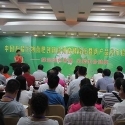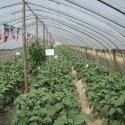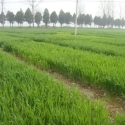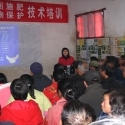08 Nov 2012
Effect of iron chelate application on citrus in the Three Gorges Area
Researchers examined methods to correct iron (Fe) chlorosis and deficiency in citrus grown on calcareous soils. Soil application of an Fe-chelate was most effective at reducing symptoms of poor Fe supply and provided a boost in fruit yield and quality.

Iron chlorosis is a major yield-limiting concern for citrus trees grown on calcareous soils. The southern provinces of Chongqing and Hubei contain a citrus production belt along the Yangtze River within the Three Gorges Area. This region plays a significant part in China’s total citrus production, yet its mountainous slopes are mainly comprised of calcareous soils. The recent extension of high productivity citrus cultivars is removing more soil nitrogen (N), phosphorus (P) and potassium (K), as well as micronutrients from these soils. Thus, among other problems, Fe deficiency is becoming increasingly more common. For example, a recent survey of orchard soils in Hubei indicates that 34% are deficient (<10 mg/kg) in Fe (Lu et al., 2002). Most micronutrient deficiencies have a significant effect on citrus yield and quality. Iron plays a highly important role in plant chlorophyll synthesis and numerous enzymatic systems. Iron chlorosis and deficiency is usually corrected through application of inorganic Fe fertilizers such as ferrous sulfate (FeSO4) and/or soluble organic compounds, or chelates, which can bind Fe and other metals within their complexes.
In calcareous soils, soil pH levels above neutrality lower Fe solubility, resulting in a high degree of ‘fixation’. Lime-induced Fe chlorosis is another concern wherein sufficient Fe concentrations exist in leaf tissues. However, excessive uptake of bicarbonate ions (HCO3) immobilizes plant Fe, thus rendering it unavailable.
Citrus response to inorganic Fe is often poor in these soils and high rates are often required. Many turn to foliar applications in these cases, although translocation can be poor and care must be taken not to cause fruit or leaf burn. Similar care must be taken with Fechelates, but they are not as susceptible to soil adsorption and are more effective at lower rates.
The authors compared methods of application for a Fe-chelate [Fe-EDDHA, (Fe content 6%)] for correction of deficiency symptoms in established (8 to 10 years old) navel orange (Citrus sinensis L.) tree orchards in Yichang, Zigui, and Yidu Counties in Hubei Province. All sites had purple soils, which are derived from parent materials high in calcium carbonate. Soils were sampled at three layers: 0 to 20, 21 to 40, and 41 to 60 cm. Micronutrients were analyzed by DTPA extraction and
atomic absorption spectrometry.
The trials consisted of randomized blocks with four replications. There were three treatments in each block and five uniform trees were selected for each treatment. Along with N, P, and K fertilizers, treatments provided: 1) common practice with no Fe fertilizer); 2) foliar application of Fechelate at 50 g per tree at 1% concentration applied during budding, early flowering, and early fruiting; 3) soil application of Fe-chelate at 50 g per tree with 2.5 kg water applied during budding.
A leaf ‘yellowish’ rating was estimated 3 to 5 days before Fe fertilization and 10, 20, and 30 days after Fe fertilization. Chlorophyll concentration was expressed as a green index value determined with a Minolta SPAD 502 meter before fruit harvest. Fruiting ratio, normal fruit ratio, and single fruit weight was also measured during the growing season (data not provided). Fruit sugar content, acid content, and vitamin C (Vc) contents were analyzed to evaluate fruit quality. Results
found the following.
Chelate applied either directly to soil or as a foliar dressing reduced the ‘yellowish’ rating for citrus leaves (Figure 1). Soil application proved especially effective at Zigui because of particularly low soil available Fe content (Table 1) and out-performed the foliar treatment significantly. By averaging observations over the three study sites, it is apparent that the soil-applied treatment was most effective. SPAD meter readings taken at Yichang and Zigui concurred with these results. The foliar treatment significantly increased leaf chlorophyll concentration over common practice, but the soil-applied treatment provided even higher green leaf index values. (Table 2).
Foliar or soil-applied Fe chelate, along with adequate N, P, and K, produced better fruit yields (Table 3). However, the soil treatment was more effective than the foliar dressing, no matter if Fe chelate was applied at low or high yielding citrus trees sites.
Citrus quality, as measured by carbohydrate, sugar, acid, and Vc content, was consistently better than common practice under the basal dressing. The foliar dressing provided intermediate improvements for a selected number of these parameters (Table 4).
Iron deficiency symptoms of citrus were significantly reduced in one or two weeks by chelate application. Citrus fruit yield and
quality can be improved by either soil or foliar treatments. However, the clear advantage of soil application over foliar treatment at these sites, especially in terms of fruit yield and quality, is valuable information for growers managing citrus
on calcareous soils. The authors are interested in expanding their study of soil applied Fe-chelates and the mechanisms contributing to the agronomic effectiveness demonstrated.




